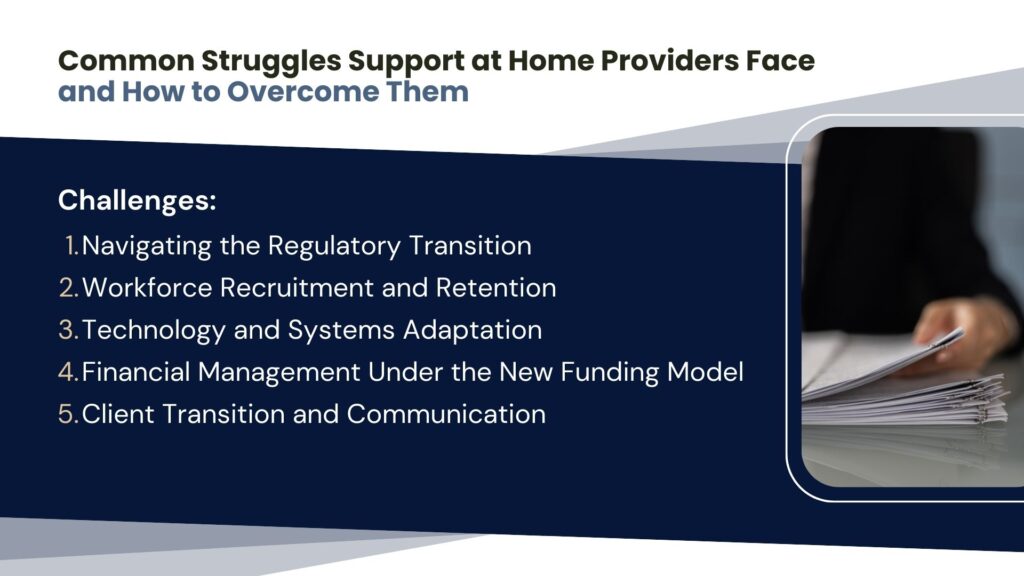The Support at Home (SAH) program, which was launched on July 1, 2025, replaced the Home Care Packages (HCP) and Short-Term Restorative Care (STRC) Programme. This initiative is part of a new model for regulating aged care, designed to simplify in-home aged care and help older Australians live independently at home for longer.
While the program offers opportunities for innovation and improved care delivery, it also introduces unique challenges for providers. This article identifies the common struggles providers may face during the transition and offers practical solutions to overcome them.
Challenge 1: Navigating the Regulatory Transition
Providers must adapt to a new regulatory framework under the Support at Home program. This includes, but is not limited to:
- New compliance requirements.
- A shift from four package levels to eight support classifications.
- Stricter reporting standards.
These changes create significant administrative burdens and operational uncertainty, particularly for smaller providers or those unfamiliar with complex regulatory environments.
Solutions
- Start preparation early by studying the Support at Home Program Handbook.
- Create a comprehensive transition roadmap with key milestones.
- Develop quality metrics that align with the new service categories and program goals.
- Consider establishing a dedicated compliance team or officer.
- Invest in training for administrative staff on the new systems.
- Engage with industry associations for guidance and updates.
- Connect with providers who successfully navigated previous reforms.
Adapting to these changes doesn’t need to be difficult or complicated. The sooner you follow these steps, the easier it will be to navigate the new landscape. It is also important for aged care businesses to stay updated on any new provider obligations in aged care that may affect their operations.
Challenge 2: Workforce Recruitment and Retention
The aged care sector is struggling with workforce shortages, especially in nursing and direct care roles. Although occupancy rates are improving, the challenge of attracting and retaining skilled staff persists, making it difficult to meet the rising demand for services.
The transition to Support at Home may exacerbate staffing pressures, as expanded service offerings require diverse skill sets. Understaffing can lead to:
- An inability to meet service demands.
- Burnout among existing staff.
- Potential compliance issues.
- Quality of care concerns.
Solutions
- Proactive recruitment strategies tailored for the aged care sector.
- Emphasis on creating quality work environments and conditions.
- Investing in staff training and development programs.
- Implementing career advancement opportunities.
- Leveraging technology for staff management and development.
- Creating clear communication channels about the transition changes.
By following these steps, hiring and retaining aged care staff becomes more manageable. That means being able to more easily meet the new and rising demands of aged care services.
Challenge 3: Technology and Systems Adaptation
Providers will need new or upgraded systems to handle the program’s requirements, including:
- Quarterly budget management.
- Tracking and reporting on the defined service list.
- Managing the assistive technology and home modifications scheme.
- Documenting contribution arrangements.
These changes may strain operations, especially for providers with outdated systems.
Solutions
- Audit current technology systems for compatibility with new requirements.
- Research care management systems designed for the Support at Home program.
- Plan for implementation and staff training well before July 2025.
- Consider cloud-based solutions that can be easily updated as requirements evolve.
- Use technology to simplify compliance documentation.
Getting the right tech to keep up with the Support at Home (SAH) program is essential, as it allows you to run a smoother operation that’s compliant with the latest regulations. To stay ahead of the game, you need to constantly review and update your technology systems to ensure they are compatible with the new requirements.

Challenge 4: Financial Management Under the New Funding Model
The new funding model introduces complexities, such as:
- Managing clients across eight support levels and two pathways.
- Handling different contribution rates based on service type and client financial status.
- Working within capped pricing structures.
- Quarterly budget management.
Transitioning existing clients under the “no worse-off” principle may also create cash flow challenges and revenue uncertainty.
Solutions
- Develop financial forecasting models specifically for the transition period.
- Create client-specific financial management plans.
- Implement systems to track different contribution rates efficiently.
- Consider offering financial guidance services to help clients understand their contributions.
- Review service pricing strategies within the new capped environment.
Effective financial management is critical for adapting to the new funding model and maintaining organisational sustainability. Strong financial oversight helps organisations remain compliant with new regulatory requirements, minimising risks of mismanagement. Additionally, transparent financial practises build trust with clients, reassuring them of the value and clarity of services provided.
Challenge 5: Client Transition and Communication
Helping existing clients transition to Support at Home involves:
- Explaining new contribution arrangements.
- Managing expectations about service continuity.
- Communicating details about the AT-HM Scheme.
Poor communication can lead to client confusion and dissatisfaction, damaging trust and reputation.
Solutions
- Create clear, accessible communication materials about the transition.
- Develop a communication timeline and plan for existing clients.
- Implement regular client feedback mechanisms specific to the transition.
- Train staff to confidently explain the changes to clients.
- Host information sessions for clients and their families.
- Provide personalised transition plans for each client.
- Establish clear quality expectations with clients.
Effective client transition and communication are crucial for maintaining trust and minimising disruptions during periods of change. By following these steps, you’ll have clear communication that ensures clients feel informed, supported, and confident throughout the transition process.
Choose SAH Consulting for a Smooth Transition
Understanding the changes to aged care under the new model for regulating aged care can be overwhelming. But there are ways to ensure you stay compliant. SAH Consulting specialises in guiding providers through this transition, ensuring a seamless and efficient process.
With extensive experience in aged care reforms, our team offers specialised knowledge and practical solutions tailored to your needs. Here’s how working with SAH Consulting can benefit your organisation:
- Understand the new regulations: We simplify complex guidelines and provide clear, actionable advice.
- Prepare a robust application: We assist in gathering documentation and ensuring accuracy for compliance.
- Develop policy and procedure documentation: We create comprehensive frameworks to meet regulatory standards.
- Address concerns: Our team is available to resolve challenges and answer questions throughout the process.
- Minimise delays: We streamline the application process to ensure timely outcomes.
By partnering with us, you can confidently navigate the changes to aged care and focus on delivering high-quality services under the new Support at Home program.
Have a Smooth Support at Home Transition With SAH Consulting
The transition to the Support at Home (SAH) program marks a significant shift in Australia’s aged care landscape. As part of the new aged care standards, the program introduces both opportunities and challenges. Providers must prioritise early preparation and strategic planning to navigate regulatory changes, workforce demands, technology upgrades, and financial complexities effectively.
Despite these challenges, the future of aged care under Support at Home is promising. The program’s focus on independence, equity, and quality care aligns with the evolving needs of older Australians. Take the first step toward a seamless transition.
Book a free consultation with SAH Consulting today and ensure your organisation is ready to succeed under the new model for regulating aged care.
